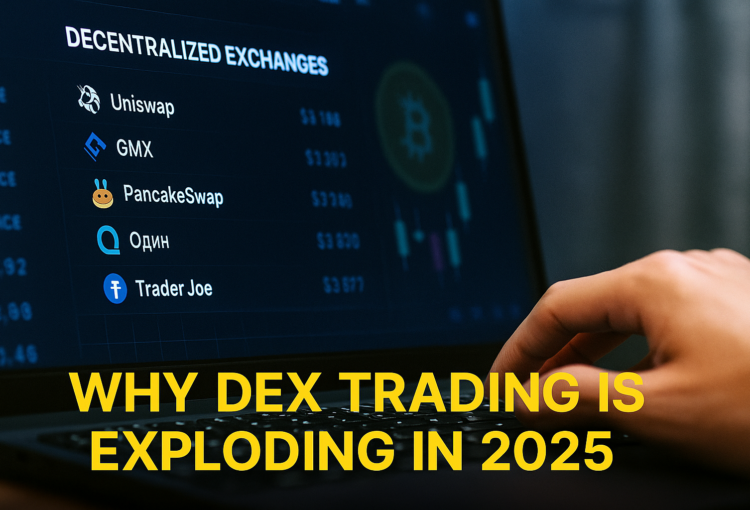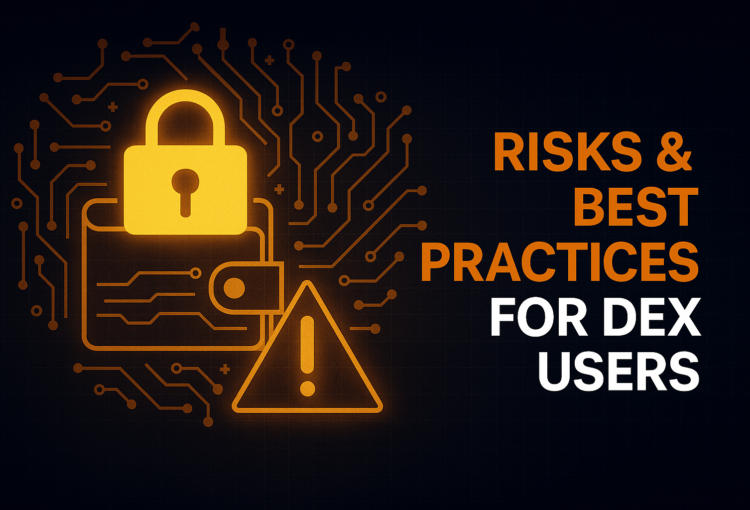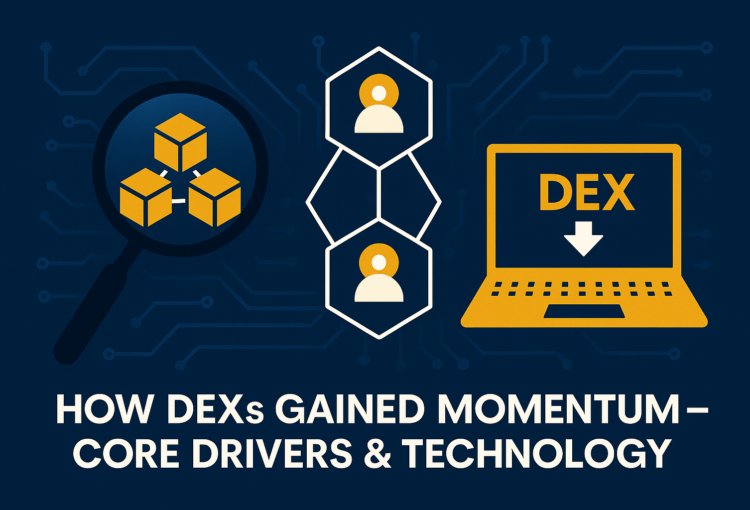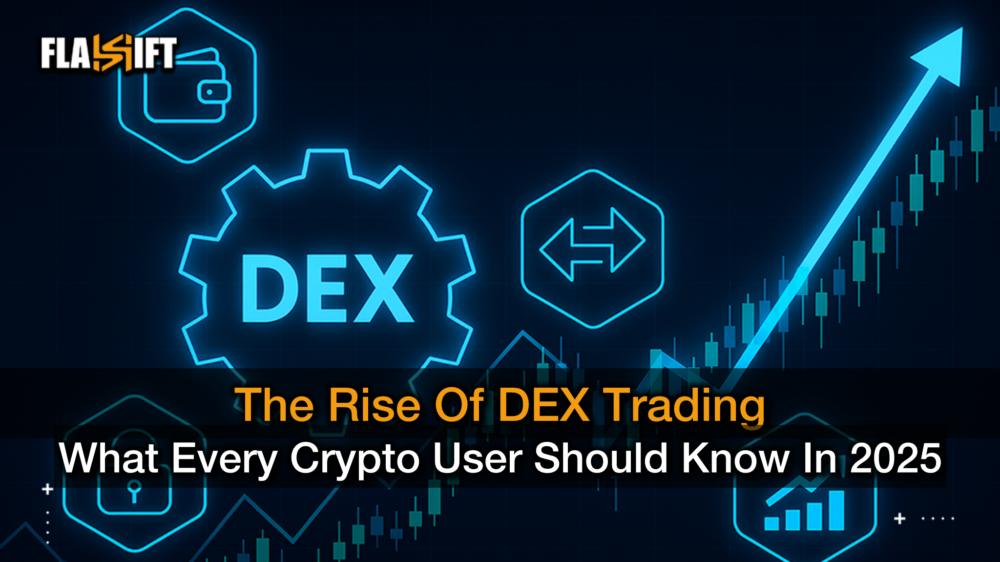DEX Trading | If 25% of all spot trading now happens on decentralized exchanges, you’re not imagining things; decentralized exchanges (DEXs) are taking over the crypto world. In June 2025, data showed DEXs captured around 27.9% of global spot volume, with trading volumes having more than doubled year-over-year. This explosive momentum has more than just market analysts buzzing; it’s redefining how crypto users trade, protect assets, and interact with DeFi.
In this article, Flashift will walk you through why decentralized exchanges (DEXs) and DEX Trading have surged: from non-custodial control and cross-chain innovation, to AI-enhanced routing and Layer 2 scalability. You’ll gain clarity on the benefits, the risks, and the future roadmap, so whether you’re swapping tokens on Uniswap, exploring derivatives on dYdX, or just curious about what makes DEXs tick, you’ll come away equipped with everything every crypto user needs to know in 2025.
Why DEX Trading Is Exploding in 2025

Decentralized Exchange (DEX) trading has surged in popularity this year, capturing a roughly 27.9% share of global crypto spot trading volume in June 2025, up from less than 10% just 18 months ago.
DEX Market Share Hits 25% of Global Crypto Volume
Decentralized Exchanges (DEXs) are no longer niche, they now account for nearly 28% of all global spot trading volume, reaching an all-time high in June 2025. That’s a jump from under 10% just 18 months ago and reflects a market that increasingly values on-chain execution over centralized systems research.
User Preference for Non-Custodial, Peer-to-Peer Trading
Crypto users are opting for non-custodial experiences, preferring to trade directly from their wallets without KYC requirements or intermediaries. This shift toward peer-to-peer swap patterns is rapidly accelerating, partly in response to privacy concerns, but also because users value direct control over their funds.
Multichain Liquidity & Cross-Chain Bridges
What making DEXs even more powerful in 2025, is Cross-chain integration. Platforms like LI.FI, Symbiosis, and 1inch now support swaps across dozens of networks, Ethereum, Solana, BNB Chain, Avalanche, and beyond. These tools unite liquidity from multiple chains, giving traders better access to assets and rates .
Risks & Best Practices for DEX Users

Navigating decentralized finance means weighing powerful benefits against inherent risks. From exploit-prone smart contracts to slippage and impermanent loss, it’s essential to choose fully audited platforms and stay alert. Prioritize reputable tools and strategies, like impermanent-loss protection and MEV-resistant routing, to trade confidently and safely.
Smart Contract Vulnerabilities & Audits
While DEXs shine in decentralization, they also carry inherent risks, namely, smart contract vulnerabilities. These can range from coding errors to logical flaws, making unaudited or untested protocols tempting targets for hackers. The best defense? Stick to audited platforms backed by reputable firms and independent security firms. Always check audit reports (e.g., MythX, CertiK) and watch for bug bounty programs, these are signs a project is actively managing risk and prioritizing user safety.
Impermanent Loss & Fee Structures
Providing liquidity to Automated Market Makers (AMMs) brings the risk of impermanent loss, a scenario where LPs end up with less value than if they simply HODL’d the tokens due to price divergence. Fortunately, innovations like dynamic fee mechanisms offer protection. A 2025 study shows that adaptive fee models, which increase transaction fees in volatile conditions, can significantly reduce impermanent loss while maintaining market activity and boosting LP rewards. Some DEXs go further, offering impermanent loss insurance or rebate programs, helping providers stay protected during sharp market moves.
Slippage, Front‑Running & MEV Protections
When executing on-chain trades, slippage can erode returns, especially during volatile periods or when hit by MEV (Maximal/ Miner Extractable Value) attacks. MEV bots exploit transaction ordering through front-running, sandwiching, or back-running, profiting at traders’ expense. To protect yourself, consider:
- Tight slippage settings to abort poor trades.
- Using MEV-aware platforms like CowSwap or those utilizing Flashbots, which offer private transaction paths or fair-batching schemes to thwart MEV interference.
Best Practices Recap
| Risk Area | What You Can Do |
| Smart Contracts | Use audited platforms with up-to-date vulnerability disclosures |
| Impermanent Loss | Look for dynamic fee models, IL insurance, or rebate mechanisms |
| Slippage & MEV | Set tight slippage tolerance and use MEV-aware interfaces for protection |
How DEXs Gained Momentum, Core Drivers & Technology

The surge in DEX adoption is driven by three pivotal innovations: more capital-efficient AMMs with advanced liquidity mechanics, AI-enhanced trade routing for lower slippage, and seamless scalability through Layer‑2 networks and multichain bridges. These technologies together have transformed DEXs into smart, user-friendly platforms ready for mass adoption.
AMMs and Liquidity Aggregation Power Swaps
Automated Market Makers (AMMs) remain the backbone of DEX innovation. The latest generation, like Uniswap v4, introduces concentrated liquidity and modular smart contract “hooks,” letting liquidity providers tailor capital bands and dynamically adjust fees. These improvements increase capital efficiency and reduce user costs. Furthermore, aggregation services, including platforms such as Flashift, ombine liquidity across multiple AMMs, enabling users to get optimal rates without manually hunting for each pool.
AI‑Driven Trading and Smart Routing
Artificial intelligence is beginning to reshape how trades are executed on-chain. Today’s AI-powered protocols can analyze fragmented liquidity pools, identify the lowest slippage paths, and optimize routing in real-time. These solver-based technologies dynamically adapt to changing market depth and price impact, helping users get better execution while avoiding costly front-running pitfalls. Flashift integrates similar AI routing logic to streamline trades and reduce execution risk for everyday users.
Read More: AI in Cryptocurrency Trading: Opportunities and Risks
Scalability Through Layer‑2 & Chain Interoperability
Decentralized trading has grown more robust thanks to the rise of Layer 2 networks and cross‑chain bridges. Solutions on Optimism, Base, Polygon zkEVM, Solana, and others now support high-speed, low-cost swaps. Cross-chain bridges connect these ecosystems, enabling seamless asset transfers and unified liquidity. As a result, DEXs can tap into a much broader liquidity pool, offering better prices and deeper markets for users, wherever they choose to trade.
What’s Next, The Future of DEX Trading
Decentralized Exchanges (DEXs) are rapidly evolving beyond basic token swaps into sophisticated trading platforms featuring on-chain derivatives, perpetual contracts, and hybrid order-book models, signaling a future where DeFi supports institutional-grade strategies alongside retail traders. Looking ahead, breakthroughs like post-quantum cryptography will strengthen on-chain security, while emerging regulatory frameworks aim to harmonize DeFi operations with global compliance standards. Finally, as institutions and traditional finance integrate with decentralized protocols, DEXs are poised to become core infrastructure in 2025, powering seamless asset management and transparent liquidity across the broader crypto ecosystem
Decentralized Derivatives, Perpetuals & Order-Book DEXs
The future of DEXs is expanding beyond simple token swaps. Today, decentralized derivatives platforms like dYdX and GMX are redefining crypto trading with perpetual contracts and leverage, offering clear alternatives to traditional order-book models. Meanwhile, newer entrants like Hyperliquid, boasting $1.7 billion in TVL and daily volumes exceeding dYdX, are demonstrating how on-chain composability drives rapid ecosystem growth through developer tools and yield-sharing programs. Together, these platforms point to a future where advanced financial instruments are traded trustlessly and permissionlessly.
Post‑Quantum Security & Regulatory Evolution
As DEXs mature, so does the attention of regulators and technologists alike. Emerging frameworks like MiCA in Europe and evolving SEC guidelines in the U.S. are shaping transparent, compliant practices for decentralized infrastructure. At the same time, the industry is preparing for quantum-resistant cryptography, with research accelerating on post-quantum signature schemes and network upgrades to safeguard long-term asset security .
Institutional Adoption & DeFi Ecosystem Integration
Institutional market-makers, including firms like Marex and Jump Trading, are increasingly engaging in DEX liquidity provisioning, helping shrink bid-ask spreads and mature market depth. Simultaneously, DeFi protocols are integrating DEX rails into lending, yield strategies, insurance, and real-world asset tokenization, cementing decentralized exchanges as durable infrastructure rather than experimental tools.
Conclusion
The next wave of DEX trading and evolution is already underway: expect to see derivatives and order books syncing with permissionless liquidity, quantum-safe security standards, and institutional-grade engagement shaping a future where decentralized trading is seamless, secure, and scalable. In 2025 and beyond, decentralized exchanges aren’t just part of the ecosystem, they’re becoming its backbone.
FAQ
-
What is a decentralized exchange (DEX)?
A DEX is a peer-to-peer trading platform where users swap tokens directly through smart contracts, no central authority, no custody of funds, and users maintain control with their wallets.
-
Why are DEXs gaining such momentum in 2025?
DEXs now account for about 28% of all global crypto spot trading volume, driven by non-custodial control, multichain interoperability, and better user experience .
-
How can I minimize slippage on a DEX?
Quality slippage control involves trading high-liquidity pairs, using aggregator platforms (like Flashift), and setting tighter slippage tolerances in the interface.
-
What is impermanent loss and how can I avoid it?
Impermanent loss occurs when the value of assets in a liquidity pool shifts relative to just holding them. To reduce risk, use stablecoin pools, or choose pools with dynamic fee structures that adapt to market volatility .
-
Are DEXs secure?
DEXs eliminate custodial risk but expose users to smart contract vulnerabilities. Always check platforms for reputable audits and bug bounty programs before engaging.
-
How do I verify the token I’m trading is genuine?
Always verify token contract addresses using official sources or blockchain explorers. Avoid unfamiliar tokens or ones with low trading volumes.
-
Do I need KYC to use a DEX?
No. Most DEXs are non-custodial and KYC-free, letting users trade directly from their wallets, perfect for maintaining privacy while staying compliant.
-
How do MEV or front-running attacks affect DEX trades?
MEV bots may manipulate transaction ordering to profit at your expense. Use MEV-resistant aggregators, fair-order DEXs, or batch-routing tools to avoid these issues.
-
Can I trade advanced instruments like futures or leveraged products on a DEX?
Yes, platforms like dYdX, GMX, and hybrids are now enabling perpetuals and order-book trading on-chain, as DeFi moves beyond spot swaps.
-
What should I watch for in the future of DEX trading?
Look for growth in decentralized derivatives, post-quantum security improvements, and deeper institutional integration, all set to shape the next phase of DeFi infrastructure .







